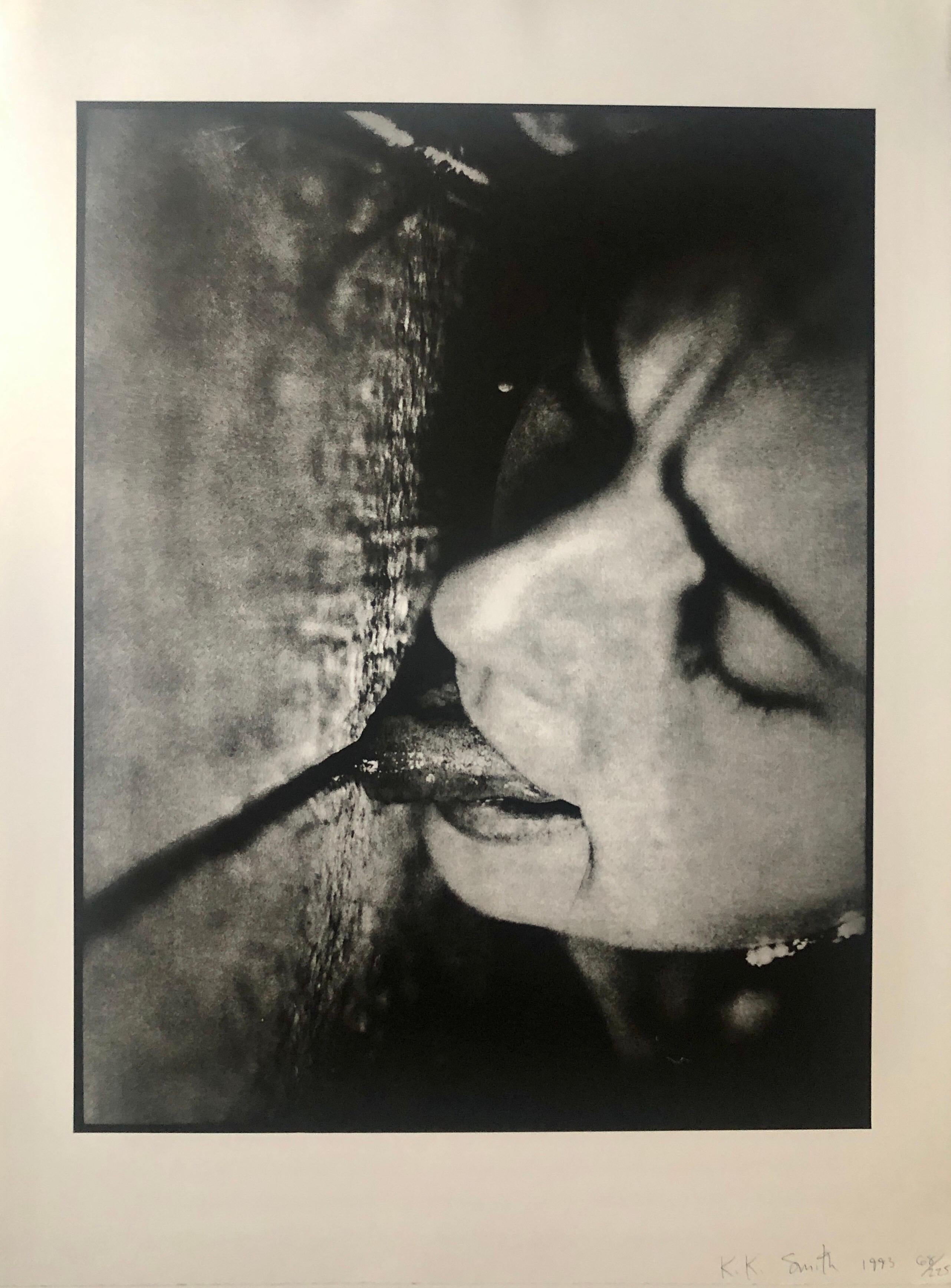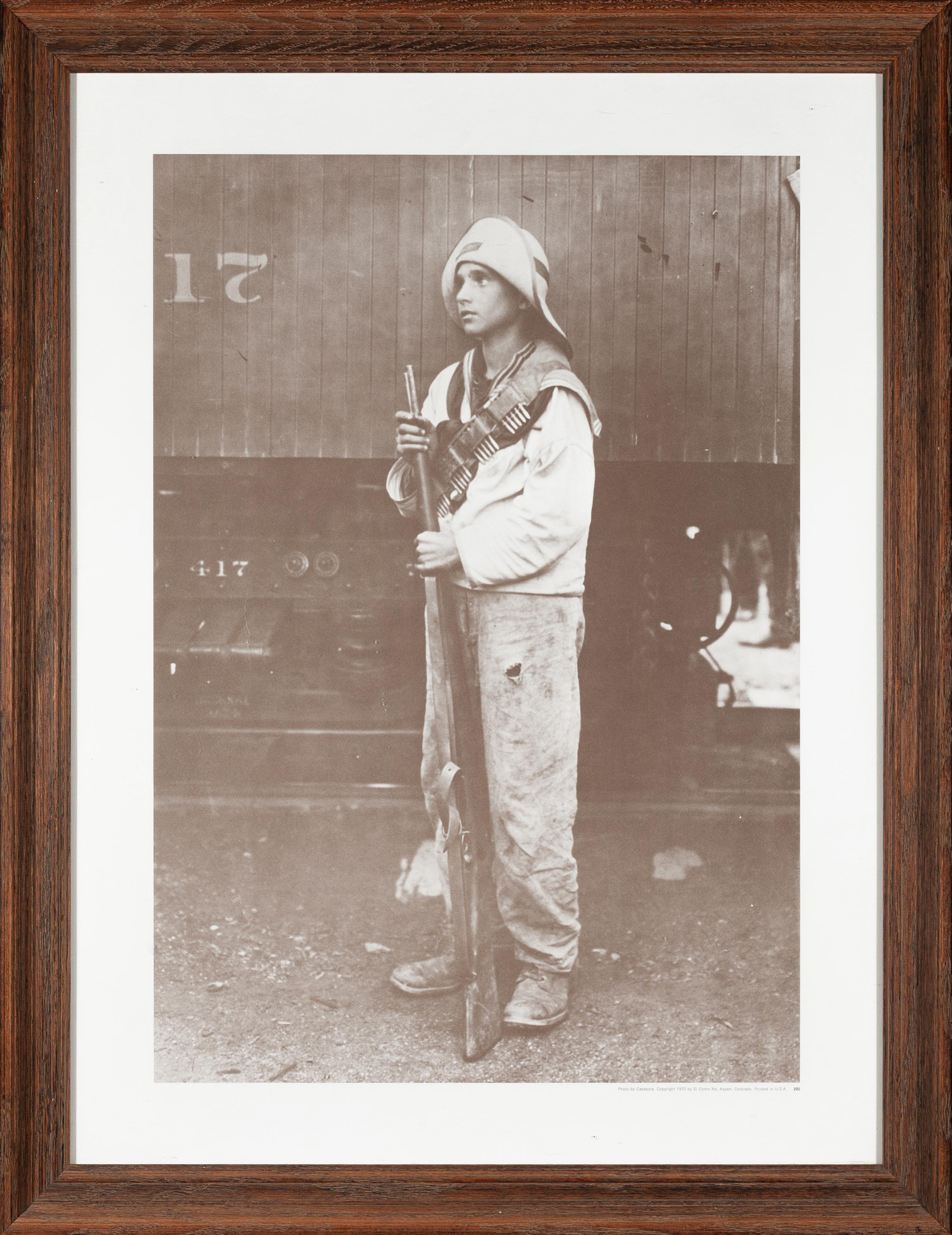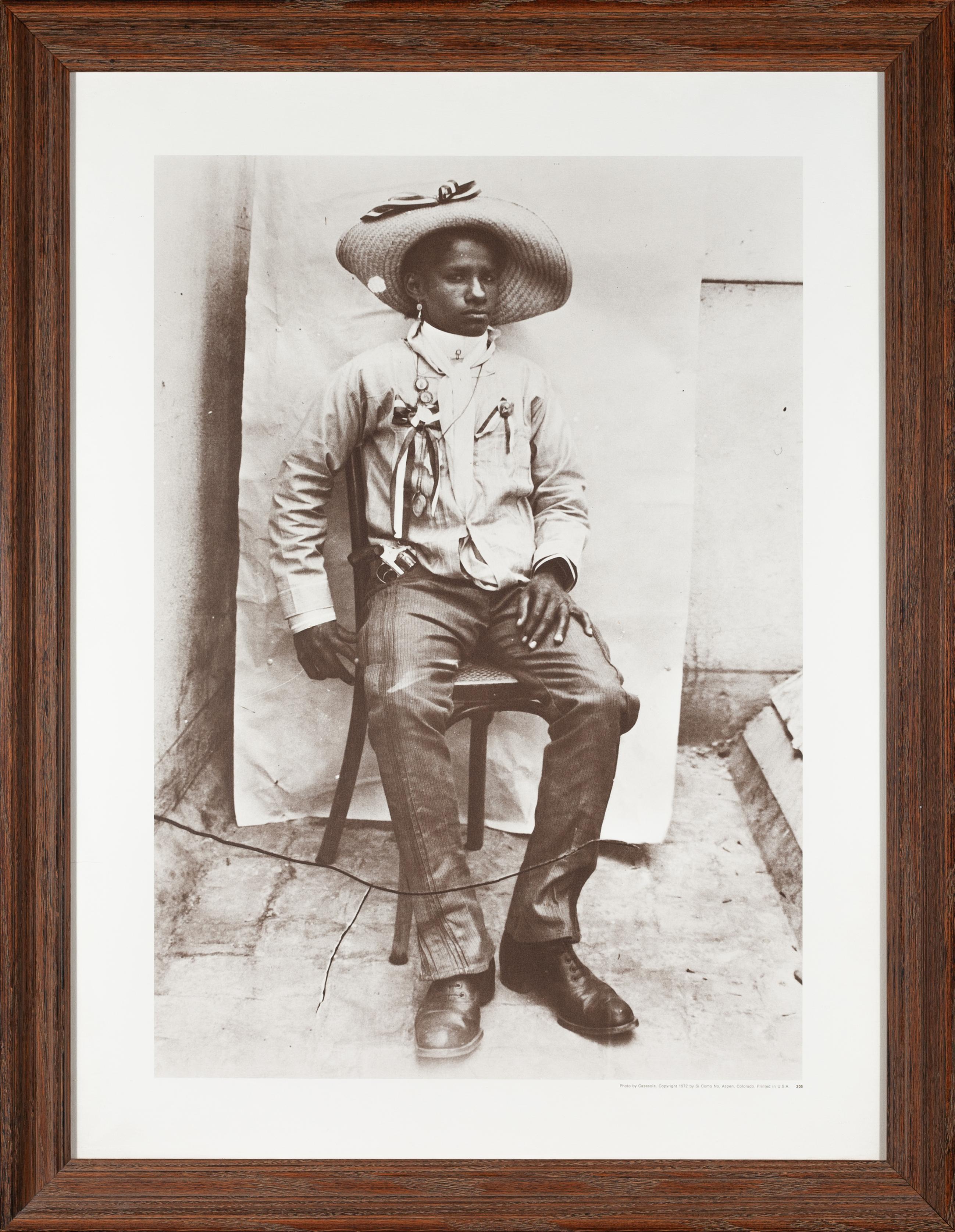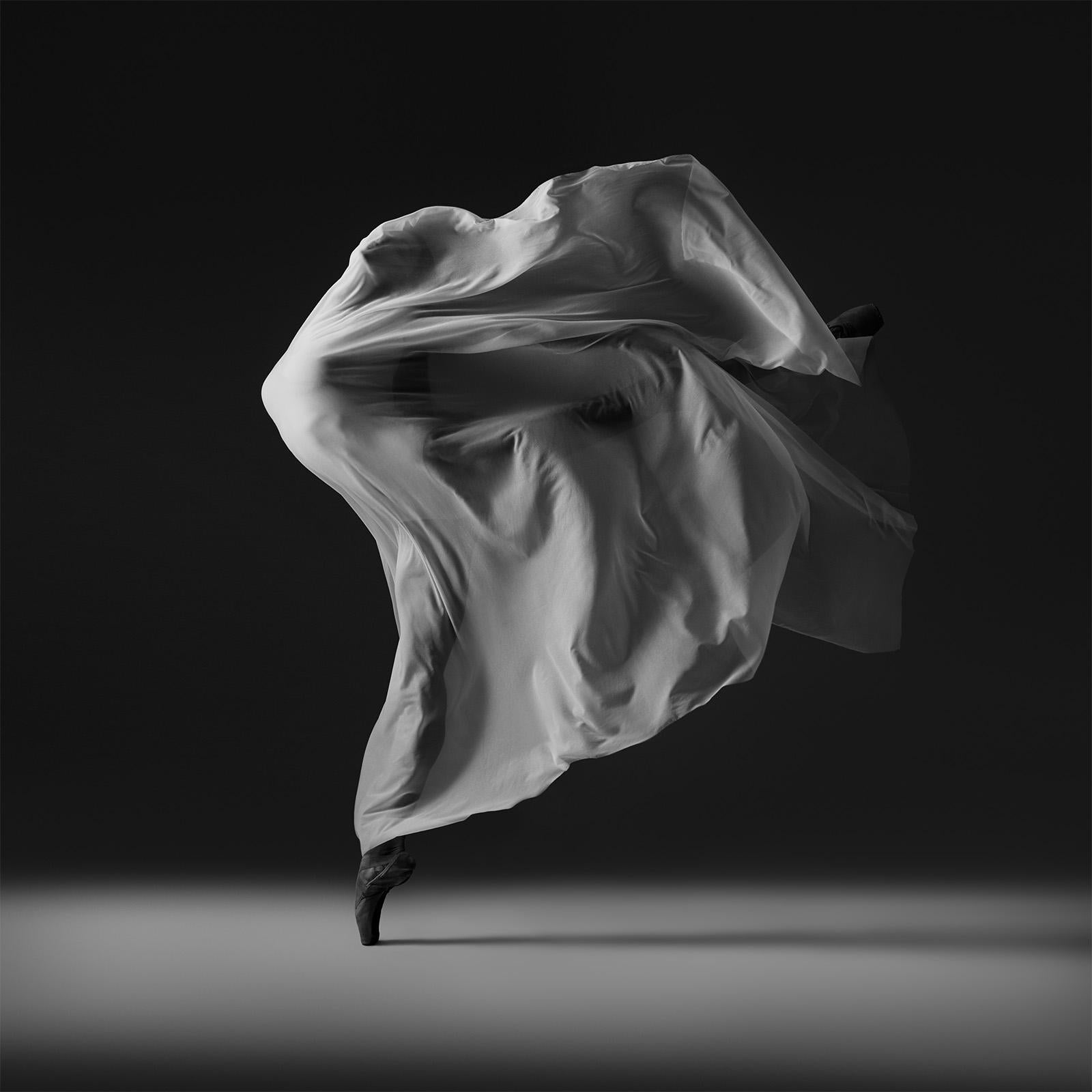Items Similar to Photo Lithograph Jannis Kounellis Arte Povera Italian Avant Garde Etching
Want more images or videos?
Request additional images or videos from the seller
1 of 12
Jannis Kounellis Photo Lithograph Jannis Kounellis Arte Povera Italian Avant Garde Etching1969-1972
1969-1972
About the Item
'Lo faro il litterato tutta la vita'
Photo Lithography on rag paper
hand signed lower right in pencil: Kounellis
numbered 37/90.
Provenance: The Collection of Ileana Sonnabend (Mrs Leo Castelli) & the Estate of Nina Castelli Sundell
I have seen this piece identified as being 1969 and I have seen it as 1972.
Jannis Kounellis (Greek: Γιάννης Κουνέλλης; 23 March 1936 – 16 February 2017) was a Greek Italian contemporary artist based in Rome. A key figure associated with Arte Povera, he studied at the Accademia di Belle Arti in Rome.
Kounellis was born in Piraeus, Greece in 1936. He lived in Greece during the Second World War and Greek Civil War before he moved to Rome in 1956. From 1960 to 1966, Kounellis went through a period of only exhibiting paintings. In some of his first exhibitions, Kounellis began stenciling numbers, letters, and words onto his canvases, often reflecting advertisements and signs seen on the street. In 1960 he began to introduce found sculptural objects such as actual street signs into his work, exhibiting at Galleria La Tartaruga. This same year he donned one of his stencil paintings as a garment and created a performance in his studio to demonstrate himself literally becoming one with his painting. This newfound convergence of painting, sculpture, and performance was Kounellis' way out of traditional art. By 1961 he began to paint on newspaper to reflect his feelings towards modern society and politics. From 1963, Kounellis introduced found objects in his artworks, among them live animals but also fire, earth, burlap sacks, and gold. He replaced the canvas with bed frames, doorways, windows or simply the gallery itself. Kounellis' work from the 1980s, which also consisted of sculptures and performances using unusual materials, traveled all over Europe. In 1974, he performed with Edward Kienholz, Wolf Vostell and other artists in Berlin at the ADA – Aktionen der Avantgarde. His work has become integral to numerous renowned, international museums' collections.
In 1967, Kounellis became associated with Arte Povera, a movement theorized by curator Germano Celant as a major shift from work on flat surfaces to installations. Kounellis participated in the exhibition 'Arte Povera – e IM Spazio' at the La Bertesca Gallery in Genoa curated by Celant, Arte povera means literally ‘poor art’ but the word poor here refers to the movement’s signature exploration of a wide range of materials beyond the traditional ones of oil paint on canvas, bronze, or carved marble. Materials used by the artists included soil, rags and twigs.
Leading artists were Giovanni Anselmo, Alighiero Boetti, Pier Paolo Calzolari, Luciano Fabro, Piero Gilardi, Jannis Kounellis, Mario Merz, Marisa Merz, Giulio Paolini, Pino Pascali, Giuseppe Penone, Michelangelo Pistoletto, Emilio Prini and Gilberto Zorio. They worked in many different ways. They
worked in painting, sculpture and photography and made performances and installations, creating works of large physical presence as well as small-scale gestures. To solidify the movement, Celant curated yet another group show, 'Arte Povera', which was exhibited at the De' Foscherari gallery in Bologna in 1968 with similar artists. In the same year Kounellis exhibited 'Senza titolo (Untitled)', which consisted of raw wool, rope and a wooden structure all leaning against a wall. Finally, Kounellis was also included in 'RA3 Arte Povera + Azioni povere' which was organized by Marcello Rumma and curated by Celant.
In 1967, Kounellis installed "live birds in cages along with rose-shaped, cloth cut-outs pinned to canvas" alongside his painting. Through this shift in his work, "Kounellis was more interested in anarchical freedom from linguistic norms and conventional materials. The space of the gallery and the exhibition site in general were transformed into a stage where real life and fiction could join in a suspension of disbelief." The viewers became part of the scene of these living natural sources of energy within the gallery space. He continued his involvement with live animals later in 1969, when he exhibited twelve living horses, as if they were cars, in the Galleria l'Attico's new location in an old garage in Via Beccaria. Gradually, Kounellis introduced new materials, such as propane torches, smoke, coal, meat, ground coffee, lead, and found wooden objects into his installations. He also looked beyond the gallery environment to historical (mostly industrial) sites. In 1997, Kounellis installed thirteen wardrobes and two doors that were sealed in lead along a scaffolding ledge that blocked the entry to a central hall. In 1968, in an interview by Marisa Volpi, Kounellis stated that incidental adjustments are certain as aspects that can indicate the human liberty of life.
Selected Solo Exhibitions
1960: La Tartaruga gallery, Rome
1969: Attico Gallery, Rome
1981: Van Abbemuseum, Eindhoven
1982: Whitechapel Art Gallery, London
1988: Castle of Rivoli, Turin
1996: Museo Nacional Centro de Arte Reina Sofía, Madrid
2005: Albertina, Vienna
2007: Neue Nationalgalerie, Berlin
2007: Kounellis - Jaffa Port, Jaffa, Israel
2009: Tate Modern, London
2012: Goulandris Museum of Cycladic Art, Athens
2016: Centro de Arte Contemporáneo Wifredo Lam, Havana, Cuba
2016: Monnaie de Paris, Paris
2016: The Negev Museum of Art, Beersheva, Israel; curator Adachiara Zevi;
Arte Povera group shows
1967: 'Arte Povera – e IM Spazio', La Bertesca Gallery, Genoa
1968: 'Arte Povera', De Foscherari gallery, Bologna
1968: 'RA3 Arte povera + Azioni povere', Arsenali della Republica, Amalfi
1969: 'Live in Your Head: When Attitudes become Form', Kunsthalle, Bern
1969: 'Op losse schroeven: situaties en cryptostructuren' 1969 Stedelijk Museum, Amsterdam
1970: 'Conceptual Art, Arte Povera, Land Art', Galleria Civica d Arte Moderna, Turin
1982: 'Arte Povera, Antiform, Sculptures 1966–69', CAPC Centre d'Arts Plastiques Contemporains, Bordeaux
2001: 'Zero to infinity: Arte Povera 1962–1972', Walker Art Center, Minneapolis
International exhibitions
Kounellis has participated in many international exhibitions, including the Biennale of Paris (1971),Documenta (1972, 1977, 1982), the Venice Biennale (1972, 1976, 1978, 1980, 1984, 1988, 1993, and 2011), the Istanbul Biennial (1993), and the Biennale of Sydney (2008). His work has also been exhibited in many museums and institutions such as the Kunstmuseum in Bern, the Museum Boijmans Van Beuningen in Rotterdam, The Musée d'Art Moderne de la Ville de Paris, the Whitechapel Art Gallery in London, The Museum of Contemporary Art in Chicago, the Museo Nacional Centro de Arte Reina Sofía in Madrid, and the Neue National gallery in Berlin. In 1994, Kounellis held an exhibition titled Ionion, in which he displayed his work on a boat docked in his town of birth in Piraeus, Greece. He later curated another exhibition that on another ship called Apollo in 1973 as an addition to "Ionion".
In October 2009, Kounellis exhibited many works at Tate Modern Gallery in London, United Kingdom. Jonathan Jones of The Guardian newspaper noted that his "Dry-stone walling, sacks of grain and rice, and a painting that includes part of the score of St John Passion by JS Bach, bring a sense of real life, organic and ancient, into the museum."
On 16 February 2017, Kounellis died at the Villa Mafalda hospital in Rome.
His estate is represented by Gavin Brown's enterprise, New York/Rome and Sprovieri, London.
- Creator:Jannis Kounellis (1936 - 2017, Greek)
- Creation Year:1969-1972
- Dimensions:Height: 17.5 in (44.45 cm)Width: 19.75 in (50.17 cm)Depth: 0.1 in (2.54 mm)
- Medium:
- Movement & Style:
- Period:
- Condition:good. minor wear. with full margins. A horizontal crease runs along the top sheet edge. please see photos.
- Gallery Location:Surfside, FL
- Reference Number:1stDibs: LU38214281212
Jannis Kounellis
Jannis Kounellis was the major exponent of the Italian art movement Arte Povera in the 20th century. Kounellis was born in Piraeus, Greece, in 1936. He lived in Greece during the Second World War and Greek Civil War before he moved to Rome in 1956.
About the Seller
4.9
Platinum Seller
These expertly vetted sellers are 1stDibs' most experienced sellers and are rated highest by our customers.
Established in 1995
1stDibs seller since 2014
1,556 sales on 1stDibs
Typical response time: 1 hour
- ShippingRetrieving quote...Ships From: Surfside, FL
- Return PolicyA return for this item may be initiated within 3 days of delivery.
More From This SellerView All
- Kiki Smith Offset Lithograph Photograph "My Secret Business" Photo Litho PrintBy Kiki SmithLocated in Surfside, FLMy Secret Business, 1992-1993 Duotone offset litho, Lithograph Sheet measures 30.13'' x 22.5'' (76 X 56 cm). 23 1/2 × 18 in (59.7 × 45.7 cm) image. Hand-signed by artist, Signed, da...Category
1990s Contemporary Figurative Prints
MaterialsPhotographic Film, Lithograph, Offset
- Curators, Catherine Opie Signed Vintage PhotographBy Catherine OpieLocated in Surfside, FLCATHERINE OPIE (b. 1961, OH), SIGNED Vintage limited edition Photograph Born in Sandusky, OH, Catherine Opie received a BFA from San Francisco Art Inst...Category
20th Century Black and White Photography
MaterialsSilver Gelatin
- Elettra, Music Score Lithograph Jannis Kounellis Arte Povera Italian Avant GardeBy Jannis KounellisLocated in Surfside, FLIt depicts a musical score or music notes. Offset Lithography on rag paper hand signed lower right in pencil: Kounellis numbered 37/90. Provenance: The Collection of Ileana Sonnabend...Category
1960s Arte Povera Abstract Prints
MaterialsLithograph
- 1971 Modernist Lithograph Redhead Pop Art Mod Fashionable Woman Richard LindnerBy Richard LindnerLocated in Surfside, FLRICHARD LINDNER (American. 1901-1978) Hand Signed limited edition lithograph with blindstamp Publisher: Shorewood-Bank Street Atelier for the Skowhegan School of Painting and Sculpture 29.25 X 22 inches Richard Lindner was born in Hamburg, Germany. In 1905 the family moved to Nuremberg, where Lindner's mother was owner of a custom-fitting corset business and Richard Lindner grew up and studied at the Kunstgewerbeschule (Arts and Crafts School since 1940 Academy of Fine Arts). From 1924 to 1927 he lived in Munich and studied there from 1925 at the Kunstakademie. In 1927 he moved to Berlin and stayed there until 1928, when he returned to Munich to become art director of a publishing firm. He remained there until 1933, when he was forced to flee to Paris, where he became politically engaged, sought contact with French artists and earned his living as a commercial artist. He was interned when the war broke out in 1939 and later served in the French Army. In 1941 he went to the United States and worked in New York City as an illustrator of books and magazines (Vogue, Fortune and Harper's Bazaar). He began painting seriously in 1952, holding his first one-man exhibit in 1954. His style blends a mechanistic cubism with personal images and haunting symbolism. LIndner maintained contact with the emigre community including New York artists and German emigrants (Albert Einstein, Marlene Dietrich, Saul Steinberg). Though he became a United States citizen in 1948, Lindner considered himself a New Yorker, but not a true American. However, over the course of time, his continental circus women became New York City streetwalkers. New York police uniforms replaced European military uniforms as symbols of authority.At a time when Abstract Expressionism was all the rage, Lindner’s painting went against the current and always kept its distance. His pictorial language of vibrant colours and broad planes of colour and his urban themes make him a forerunner of American Pop Art. At the same time, he owes the critical tone of his paintings to the influence of European art movements such as Neue Sachlichkeit and Dada. His first exhibition did not take place until 1954, by which time he was over fifty, and, interestingly, it was held at the Betty Parsons Gallery in New York, a venue associated with the American Expressionists. From 1952 he taught at the Pratt Institute, Brooklyn, from 1967 at Yale University School of Art and Architecture, New Haven. In 1957 Lindner got the William and Norma Copley Foundation-Award. In 1965 he became Guest Professor at the Akademie für Bildende Künste, Hamburg. His Ice (1966, Whitney Museum of American Art) established a connection between the metaphysical tradition and pop art. He did work on Rowlux which was used by a number of pop artists (most notably Roy Lichtenstein)The painting shows harsh, flat geometric shapes framing an erotic but mechanical robot-woman. His paintings used the sexual symbolism of advertising and investigated definitions of gender roles in the media. While influencing Pop Art (Andy Warhol, Tom Wesselmann and Claes Oldenburg amongst others) his highly colourful, hard-edge style seems to have brought him close to Pop Art, which he rejected. Nevertheless, he is immortalised on the cover of the Beatles record "Sgt. Pepper’s Lonely Hearts Club Band" (1967) as a patron of the pop culture. He also did a tapestry banner with the Betsy Ross Flag...Category
1970s Pop Art Abstract Prints
MaterialsLithograph
- AFTER THE VICTORY, PROPHECY OF ISAIAH, WPA ERA Circa 1930sBy Saul RabinoLocated in Surfside, FLA wartorn composition of a soldier on the left, a Jewish blacksmith in the middle and a little shepherd on the right. This is a lithograph pastel and colored pencil on paper. Saul Rabino (1892-1969)Best known for his paintings and drawings of Jewish culture, Saul Rabino was a Russian-bornartist who spent most of his life in Los Angeles. Born Saul Rabinowitz in 1892 in Odessa, Russia,Rabino studied art at the Russian Imperial Art School. During a brief stay in Paris, he continued hiseducation at the École des Arts Decoratifs. After mastering techniques in painting, sculpture, andlithography, Rabino moved to Los Angeles, where he worked as a WPA printmaker during the1930s. He stayed in Los Angeles for the rest of his life, making work about political turmoil and theJewish community. During the 1940s, he drew allegorical images of war and the plight of Jewsin Eastern Europe. These political works, usually drawings or prints, are dramatic, symbolic, andemotionally rousing. He also made art portraying the scholars and religious leaders of the Jewishcommunity, including portraits that are more delicate than his political pieces and express anobvious admiration for the leaders of his community. Before he died in 1969, Rabino exhibitedat the World’s Fair New York in 1939, the Los Angeles Museum Historical Society of Art, and theLaguna Beach Art Society. His work is in the collection of the Los Angeles Public...Category
1930s Modern Figurative Prints
MaterialsPastel, Color Pencil, Lithograph
- Large George Grosz 1923 Lithograph Die Rauber German Expressionism WPA RealismBy George GroszLocated in Surfside, FLFrom The robbers. lithographs by George Grosz for the drama of the same name. photolithography on watermarked paper. 19 X 25.5 inches (sheet size). This is not hand signed or numbe...Category
1930s American Modern Figurative Prints
MaterialsLithograph
You May Also Like
- Mexican Revolution Portrait (1)Located in Columbia, MOArtist Unknown Mexican Revolution Portrait (1) 1972 Lithograph (poster) reproduction of original photograph c. 1917 24 x 14 inches 26.5 x 20.5 (framed)Category
20th Century Contemporary Black and White Photography
MaterialsLithograph, Silver Gelatin
- Mexican Revolution Portrait (2)Located in Columbia, MOArtist Unknown Mexican Revolution Portrait (2) 1972 Lithograph (poster) reproduction of original photograph c. 1917 24 x 14 inches 26.5 x 20.5 (framed)Category
20th Century Contemporary Black and White Photography
MaterialsLithograph, Silver Gelatin
- Mexican Revolution Portrait (3)Located in Columbia, MOArtist Unknown Mexican Revolution Portrait (3) 1972 Lithograph (poster) reproduction of original photograph c. 1917 24 x 14 inches 26.5 x 20.5 (framed)Category
20th Century Contemporary Black and White Photography
MaterialsSilver Gelatin, Lithograph
- Just Looking II by B A T I K signed limited edition POP ART Audrey HepburnBy BATIKLocated in London, GBJust Looking II by B A T I K signed limited edition POP ART print Paper Size Oversize 40 x 30" inches / 101 x 76 cm Signed & numbered by artist on front Archival Pigment print L...Category
2010s Pop Art Figurative Prints
MaterialsBlack and White, Archival Pigment
- "No title (No 29)" Photography Edition 3/28 36x36 inch by Yevgeniy RepiashenkoBy Yevgeniy RepiashenkoLocated in Culver City, CA"No title (No 29)" Photography Edition 3/28 36x36 inch by Yevgeniy Repiashenko Photography Edition of 28 (36" x 36" inch) by Yevgeniy Repiashenko Year photo was taken: 2016 Unfram...Category
21st Century and Contemporary Contemporary Figurative Prints
MaterialsArchival Pigment, Photographic Paper
- Hot CabBy Gerard GilibertiLocated in East Hampton, NYBlack & White Photograp Desert Printed to Order Unframed Also available in 20"x30" Edition of 10 $725 The area that would become Gold Point, one of Nevada’s best ghost towns, was first settled by ranchers and a few miners around 1880. A small camp was formed a few hundred yards west of the present-day townsite at an outcropping of limestone and was called Lime Point. When new discoveries of both gold and silver established the major mining towns of Tonopah and Goldfield, Nevada in the early 1900s, a flood of prospectors returned to the old Lime Point mining camp to try their luck. In 1902 silver was discovered in the area and within no time, the old camp...Category
2010s Contemporary Black and White Photography
MaterialsArchival Pigment
Recently Viewed
View AllMore Ways To Browse
Garde Italy
Industrial Photo
Greece Photo
Avant Garde Wall Art
Vintage Industrial Photos
Vintage Bird Photo
Vintage Fire Photos
Unusual Vintage Photos
Vintage Photo Pin
Vintage Flat Key
Vintage Greek Photos
Vintage Doors And Windows
Unusual Retro Photos
Italian Torches
Michelangelo Vintage
Horse Head Prints
Civil War Generals
Liberty Vintage London






